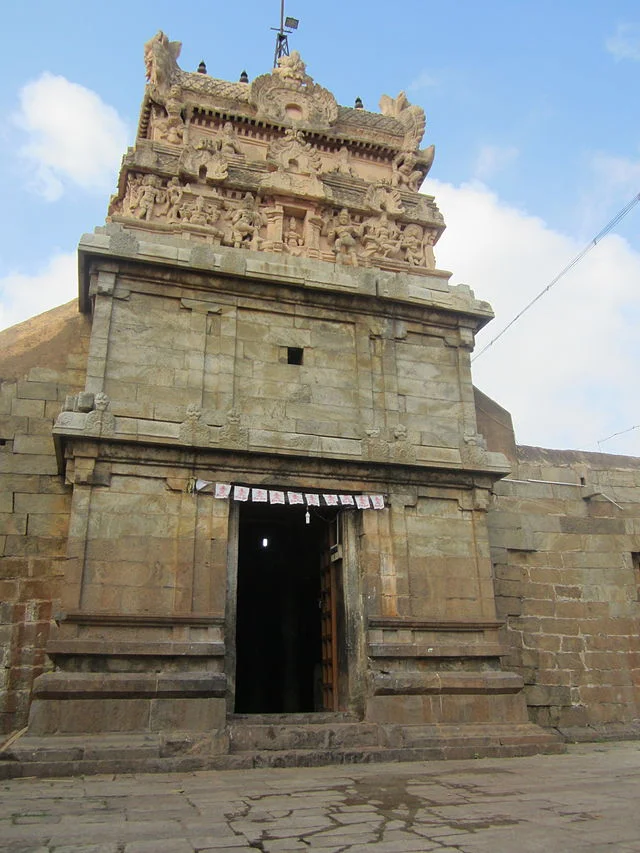Erumbeeswarar Temple, located in Thiruverumbur, Tamil Nadu, India, is a notable Hindu temple dedicated to Lord Shiva. Known for its unique hilltop position, the temple is an important cultural and historical site in South India. It was likely constructed during the Chola period, around the 9th century AD, and later renovated by successive dynasties, including the Nayakas and Marathas. Today, it stands as a remarkable example of ancient Tamil architecture and religious devotion.
Get your dose of History via Email
Historical Background
The Chola dynasty, known for its contributions to temple architecture, played a significant role in establishing Erumbeeswarar Temple. They constructed the temple during the 9th century AD, a time when Tamil Nadu saw the rise of grand temples dedicated to Hindu deities. Inscriptions found in the temple provide information about Chola rulers, such as Aditya I, who likely contributed to its construction and supported its development. These inscriptions are vital records that reveal details about the temple’s origins and its patrons.
The temple’s architecture and inscriptions also highlight the influence of later rulers. For instance, the Nayakas of Madurai made structural additions and repairs in the 16th century AD. The Marathas further contributed to the temple’s upkeep during their rule in the region. Each of these dynasties left its mark, ensuring that the temple remained a prominent place of worship.
Architectural Design
Erumbeeswarar Temple stands atop a small hill, which adds a unique architectural feature. Devotees must climb several steps to reach the main shrine, a journey that symbolizes a pilgrimage toward enlightenment. The temple’s layout reflects traditional Dravidian architectural principles, featuring a multi-tiered entrance tower, known as a gopuram, which is characteristic of South Indian temples.
The main sanctum, dedicated to Lord Shiva, enshrines a Shiva lingam, a common representation of Shiva in Hindu temples. Surrounding the main sanctum are smaller shrines dedicated to other deities, including Parvati and Vinayaka. The temple’s sculptures and carvings depict mythological scenes, religious motifs, and elaborate floral patterns. These decorations reflect the intricate artistry of Tamil sculptors during the Chola period.
Cultural Significance
Erumbeeswarar Temple holds a special place in Tamil culture and literature. The temple is mentioned in the Tevaram, a collection of Tamil hymns composed by Saivaite saints from the 7th to 9th centuries AD. Appar, one of these revered saints, praised the temple in his verses, describing its significance as a spiritual retreat. The inclusion of Erumbeeswarar Temple in these sacred hymns emphasizes its importance as a pilgrimage site and as a focal point for Shiva worship in Tamil Nadu.
During the annual festival of Maha Shivaratri, thousands of devotees gather at Erumbeeswarar Temple to pay homage to Lord Shiva. The festival, dedicated to Shiva, involves various rituals, prayers, and cultural events, highlighting the temple’s ongoing religious significance.
Inscriptions and Artifacts
Numerous inscriptions discovered at Erumbeeswarar Temple offer insights into the temple’s history, patronage, and religious practices. Many of these inscriptions date back to the Chola period, providing information on the rulers who sponsored the temple’s construction and maintenance. Other inscriptions mention donations from local merchants, demonstrating the temple’s role as a community-supported institution.
Artifacts, including stone sculptures, metal icons, and temple bells, further emphasize the artistry of Tamil craftsmen and their contributions to religious life. These artifacts are valuable historical records that help archaeologists and historians understand the socio-economic conditions of ancient Tamil society.
Preservation and Current Status
Over the centuries, Erumbeeswarar Temple has undergone several restoration projects. These efforts have focused on preserving the temple’s structural integrity and its historical features. The Archaeological Survey of India (ASI) has played an essential role in maintaining and conserving this historic site, ensuring that its architecture and inscriptions remain accessible for future generations.
Currently, Erumbeeswarar Temple continues to serve as an active place of worship, attracting devotees, scholars, and tourists alike. The temple stands as a symbol of South India’s architectural and spiritual heritage, embodying the artistic achievements and religious devotion of the Tamil people.
Source:

